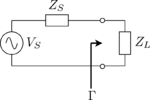chowlong
Newbie level 4
Hi all.
I am going to design a antenna to match the chip impedance with 22-196j.
What is the Terminating Impedance Zc i need to set?
Terminating Impedance mean load impedance when calculate S11(Gamma)?
From the equation Gamma = (Zc-Zo)/(Zc+Zo),
where Zc = load impedance = terminating impedance??
Zo = source/chip impedance
So the terminating impedance = 22-195j to achieve Gamma to zero.
Am i correct?
I am going to design a antenna to match the chip impedance with 22-196j.
What is the Terminating Impedance Zc i need to set?
Terminating Impedance mean load impedance when calculate S11(Gamma)?
From the equation Gamma = (Zc-Zo)/(Zc+Zo),
where Zc = load impedance = terminating impedance??
Zo = source/chip impedance
So the terminating impedance = 22-195j to achieve Gamma to zero.
Am i correct?

